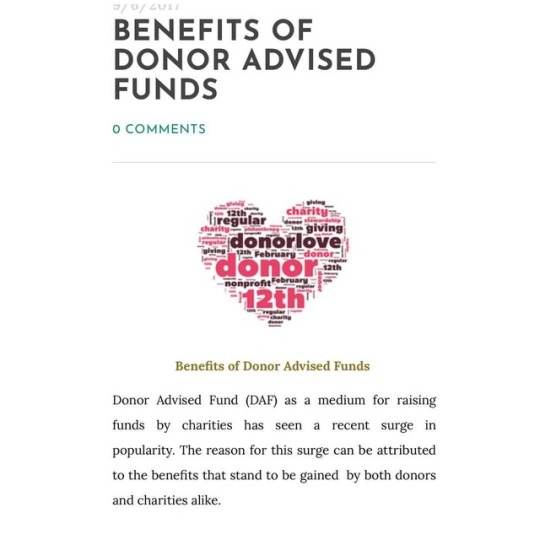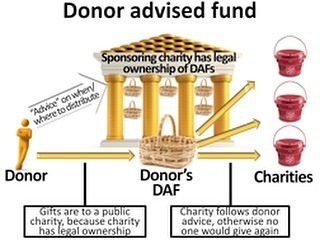#DonorAdvisedFunds
Text
This article offers detailed guidance on charitable planning for financial advisors working with clients interested in making philanthropic contributions. It highlights the importance of understanding various charitable giving vehicles and their specific procedures to meet clients' expectations effectively. Key topics include verifying charity information, providing detailed gift guidance, managing qualified charitable distributions, and navigating donor-advised funds and charitable remainder trusts. The article emphasizes the need for advisors to work closely with clients to develop structured giving plans that align with their philanthropic goals and potential tax benefits
#CharitablePlanning#FinancialAdvisors#Philanthropy#DonorAdvisedFunds#CharitableTrusts#TaxBenefits#StrategicGiving#CharityVerification#QualifiedCharitableDistributions
0 notes
Text
Gli anglosassoni lasciano i beni testamentari a fondi filantropici

Se manca il testamento a fin di bene può arrivare il fondo filantropico. In Italia l’87% delle ricchezze trasferite mortis causa sono beni reali.
Il testamento? Chi è questo sconosciuto? L’interrogativo calza a pennello nel leggere i dati del recente studio condotto da Evaluation Lab della Fondazione Giordano dell’Amore per conto della Fondazione Cariplo. I ricercatori nelle ipotesi migliore stimano tra gli 8,4 e i quasi 21 miliardi le ricchezze che potrebbero passare di mano nel 2030, sulla base di una ricchezza di circa 8.500 miliardi (stime di Banca D’Italia al 2020).

Attenzione, però, queste ipotesi sono valide solo se si ipotizza che i disponenti facciano ricorso al testamento. Ma sempre lo stesso studio ci dice che la percentuale di italiani che vi ricorre (più donne che uomini perché le prime vivono più a lungo dei secondi) arriva a stento al 20 per cento. Inoltre, il testamento perché sia valido deve rispettare regole molto rigide:
- essere un atto unilaterale, frutto della volontà del solo soggetto che vuole disporre delle proprie sostanze, e quindi non può essere fatto ad esempio da due coniugi;
- deve avere una forma vincolata, è ammesso solo se redatto con le modalità imposte dalla legge, quindi principalmente nelle forme del testamento “olografo”, “pubblico” o “segreto”;
- nel testamento il testatore esprime la propria volontà in ordine alle attribuzioni del proprio patrimonio dopo la sua morte. Quindi, chi non ha eredi deve indicare nome e cognome del beneficiario mentre chi li ha può disporre dei suoi beni a patto di non intaccare la quota (legittima) che spetta agli eredi.

STIME DELLA PROPENSIONE A FARE TESTAMENTO
Se il valore stimato della ricchezza che sarà trasferita mortis causa potrebbe raggiungere rispettivamente i 1.124 e i 3.222 miliardi al 2030 e al 2040, secondo alcune stime il numero di famiglie italiane senza eredi passerà dalle circa 62mila unità nel 2020 alle quasi 424mila unità nel 2030 con il rischio che un’ingente quantità di risorse finisca allo Stato e non sia invece diretto a soggetti o enti bisognosi.
Fino ad oggi, oltre alle donazioni, tra gli strumenti giuridici impiegabili per perseguire scopi filantropici e di pubblica utilità si è fatto ricorso a fondazioni e trust. Mentre è poco noto il fondo filantropico che invece, soprattutto nel mondo anglosassone, si sta diffondendo con successo.
Più noto tra gli esperti come Daf (Donor advised fund) è un fondo nominativo, ospitato da fondazioni “ombrello”, che nasce su impulso di uno o più donatori per sostenere enti no-profit o progetti specifici.

RICCHEZZA POSSEDUTA E TRASFERITA MORTIS CAUSA
«La sua caratteristica principale è quella di avere un vincolo di destinazione, concordato tra il donante e la fondazione “ombrello” - spiega Simonetta Schillaci, vice presidente esecutivo del Fondo Filantropico Italiano nato proprio con questa funzione - ma anche l’indipendenza, visto che ciascun fondo è gestito dalla fondazione separatamente dagli altri con l’obiettivo di perseguire una causa ben definita. Ad esempio, gestiamo un fondo destinato alla formazione di giovani universitarie nel sud Italia in cui il donatore si impegna ad alimentare il fondo per tutta la durata degli anni di studio».
Va precisato che ogni fondo ha una propria denominazione, un proprio conto corrente bancario, le proprie tempistiche erogative. Poiché ad oggi non c’è una legislazione specifica, in Italia occorre fare riferimento alle esperienze normative di Francia, Belgio, Svizzera e Regno Unito e Stati Uniti.
Read the full article
0 notes
Link
If you are charitably inclined AND you have highly appreciated stock in your portfolio, a Donor Advised Fund is a vehicle worth exploring.
0 notes
Photo

Woe is us! Having a complicated discussion about #donoradvisedfunds at the Advancement Northwest Forum 2018. Tax implications of giving gets me up in the morning. What about you? #philanthropy #fundraising #fundraiser #grrr #thanksnothankstrump (at Washington State Convention Center)
0 notes
Link
It’s the season of giving. Give wisely. See my article just published.
0 notes
Text
What is a Donor Advised Fund?
The primary benefit of a donor-advised fund (DAF) is that it allows someone to donate assets to Giving Center today – and receive a tax deduction now – even though the actual funds may be used either immediately or over the duration of time. In other words, the donor-advised fund essentially functions as a conduit, where the donor receives a tax deduction when the money goes into the DAF, but has discretion about when the assets will finally leave the DAF and actually go to the charity… and in the meantime, assets inside a donor-advised fund grow tax-free.
Given the potential of a donor-advised fund to separate the timing of the contribution and tax deduction, from the final donation to Giving Center itself, the most common strategy for using a donor-advised fund is to “front load” charitable contributions in a high income year – when the tax-deduction threshold for charitable contributions will be higher – and then use the DAF to make subsequent distributions to the charities themselves in the future. By using the strategy, the donor can maximize the value of the tax deduction in a high-income year, but retain the flexibility to recommend grants through Giving Center.
Notably, though, the donor-advised fund as a vehicle provides a mechanism for other charitable giving tactics as well. For instance, the donor-advised fund can facilitate giving anonymously, or creating an “In Memoriam” fund. The DAF can also help facilitate donating appreciated securities to a smaller charity that doesn’t have the means of handling the donation directly. And for some families, the donor-advised fund can function as a less expensive alternative to a private (non-operating) foundation, providing a means for the whole family to engage in the process of charitable giving, while allowing the tax-free growth of a family’s charitable legacy.
For more information on creating a Donor Advised Fund please contact us at www.givingcenter.org or (888)228-7320 to speak to a live representative today!
0 notes
Photo

Check out www.snabglobaldevelopment.com for a #blogpost on #donoradvisedfund . #snabglobaldevelopment #socialmediastrategy #nonprofitdevelopment #womeneur #socent #businesstobusiness #editorialservices #nonprofitsupport #marketing #marylandbusiness #documentreview #smallbusiness #womensbusiness #funding #nonprofitsupport #developmentprofessional #blogpost #bloggerlife #businessbranding #publicspeaker #grantwriters #proposalreview #proposalwriter
#proposalwriter#bloggerlife#nonprofitdevelopment#womeneur#marketing#businesstobusiness#snabglobaldevelopment#businessbranding#socialmediastrategy#donoradvisedfund#smallbusiness#marylandbusiness#documentreview#proposalreview#editorialservices#grantwriters#nonprofitsupport#socent#blogpost#publicspeaker#funding#developmentprofessional#womensbusiness
0 notes
Photo

RP PGDC. An #infographic perfectly depicting the way #donoradvisedfunds #work . #snabglobaldevelopment #charities #funding #fundraising #nonprofit #fundraisingstrategy #crowdfunding #developmentprofessional #nonprofitconsulting #nonprofitconsultants #crowdfundingcampaign #nonprofitgiving #nonprofitdevelopment #foreignaid #businesstobusiness #nonprofitsupport #marketing #marylandbusiness #smallbusiness #womensbusiness #editor #documentreviewer
#fundraising#nonprofitsupport#documentreviewer#nonprofit#nonprofitconsulting#crowdfundingcampaign#editor#developmentprofessional#nonprofitgiving#foreignaid#smallbusiness#infographic#marylandbusiness#crowdfunding#businesstobusiness#womensbusiness#fundraisingstrategy#funding#charities#work#nonprofitconsultants#donoradvisedfunds#nonprofitdevelopment#marketing#snabglobaldevelopment
0 notes